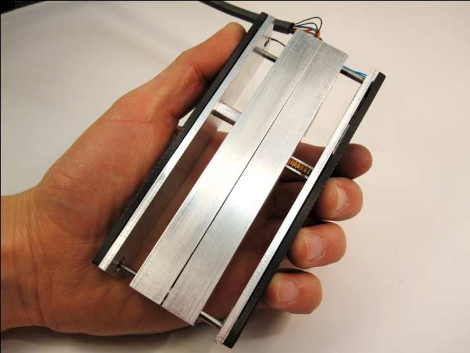
Can we do away with a keypad and just squeeze our phones to check messages and dial contacts? [Sidhant Gupta] has been researching the idea of an electronically adjustable spring mechanism that might just make this possible. He calls the prototype above the SqueezeBlock. If you pick it up and give it a squeeze you can feel springs pushing back against your fingers, but it’s all a trick. Inside you’ll find one motor with a gear that converts the linear motion into a rotating force. Attached to the same axle as that gear are a motor and a rotary encoder. A microcontroller monitors that encoder to detect a user squeezing the two plates together, then drives the motor to vary the resistance. [Sidhant] outlines some possible uses that included stiffer resistence as unread email starts to pile up, or squeezing the device to its smallest size to turn the ringer volume all the way down.
We’re a little skeptical of this functionality in handhelds just because of the power consumption issue. But if that is somehow overcome we think this would make a pretty interesting phone feature… at least at first. Click through the link above for a video demonstration or get the details from the research presentation (PDF)
[Thanks Dan]














I think we all know that electro-motive parts and parts which the user touches are the first to fail. Mostly that which the user touches. If this idea is deemed good for phones, it will be many years before it is implemented. The main factor would be failure rate.
Another problem I see with this device is the mechanical portion. Not, just failure, but wear. The electro-motive spring mechanism requires a mechanical piston effect. Just like in your car, a piston will wear out. In a smaller electronic device, this piston would be subject to 120+psi (my own grip strength). Near the end of it’s life, my iPhone’s case would squeak and creak when I would apply a death grip to it. Smaller form factors mean less rigidity in the structure.
The next factor would be size concerns. How would you squeeze the squeeze-block without having wasted, empty space inside the device? One of the biggest concerns in mobile electronics is the size of the device. People want bigger screens, larger processors, better battery life…. but the reviews on those devices always say that they are too big.
For now, haptic feedback is used on my Android phone in the form of vibration on soft-touch buttons. Maybe a squeeze-block-esque device could use vibration to let the user push a button and feel the intensity of vibration to let him or her know that there are more emails to be read?
@Adam Outler,
Apple already has several patents on haptic feedback for phones: http://www.tuaw.com/2010/06/25/apple-patents-another-haptic-feedback-solution/
Although a slightly different implementation, the ideas are the same, and it shows the interest of phone companies such technologies.
Power shouldn’t be an issue, that squeezing motion should be easy to harness for power generation. Heck it should have a mode where the squeezing only generates power, maybe people would stop chewing their pens in meetings and start squeezing their phones (better? probably not).
@Simonious: The device uses power to spring back out. Every time you squeeze it together it has to use power to open back up again, thus negating any power generated.
If a spring is used to open it up there can still be a net gain in energy.
@jordan That implementation is lame to say the least. I cannot immagine that being useful. it would actuate the entire screen up and down. That would make the screen feel flimsy and leave no structural rigity. Also, a bit of dirt getting into the side would cause issues in the phone. Look at that design. It would allow for about 1mm of movement.
@sneakypoo
Motion consumes no energy. So long as the resistance used for the power generation cycle is removed and the device is allowed to spring back out on its own, you’ll have energy gain. Imagine magnetic breaks being applied while squeezing and the same breaks being removed or blocked when it springs back. The problem is getting a working system at the size of a cellphone.
This seems more practical: http://www.newscientist.com/article/dn19510-nokia-touchscreen-creates-texture-illusion.html
Who wants to make the first DIY version and get sued?
@Bob: But this device uses the little motor inside for movement, both in and out. There is no mechanical spring to allow it to open back up, that would defeat the whole purpose of the device; being a virtual spring.